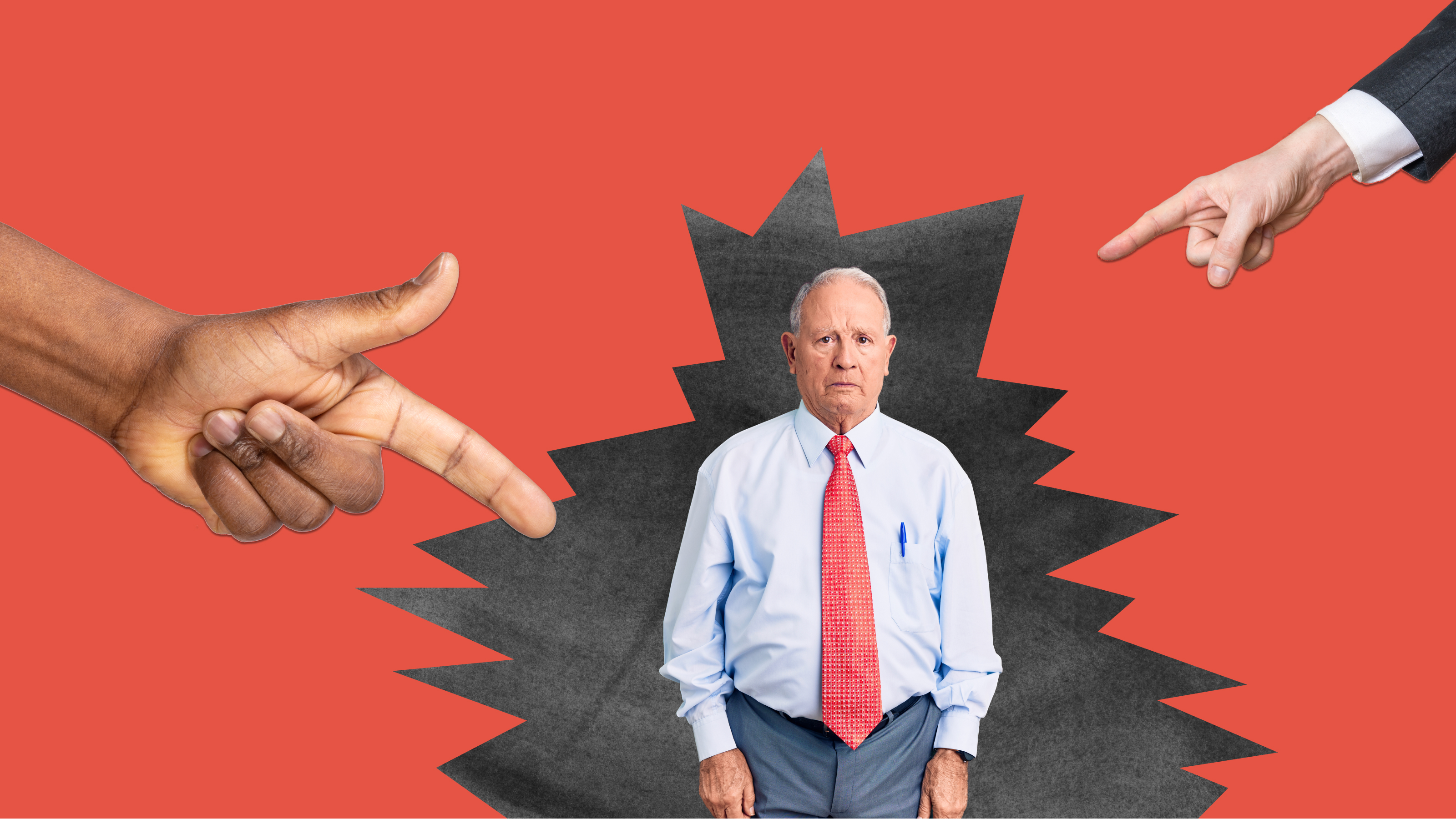4 ways to identify high-conflict people before it’s too late

- High-conflict people can be found at work, in social circles, or among your family.
- Lawyer and therapist Bill Eddy has identified four characteristics that describe the high-conflict people in your life.
- To manage these relationships, it’s important to analyze your options, set limits, and respond to their behaviors appropriately.
Some people seem predisposed to cause chaos and conflict in their lives. Their every discussion regresses into an argument. Everywhere they go, something goes wrong and someone else is to blame. And they can’t let anything go, seeing even the smallest mistake as an affront to their worthiness.
These are some of the signs of what lawyer and therapist Bill Eddy calls “high-conflict people,” and chances are you’ve encountered one before. They could be that coworker whose ego you have to tiptoe around at the office, the family member who adds drama to every holiday visit, or the friend who reacts explosively to the mere suggestion that they’ve misremembered some trivial fact.
The question is: How do you tell the difference between a high-conflict personality and simply two personalities that conflict with each other? In an interview, Eddy shared the four key characteristics you can use to identify such personalities.
How to identify high-conflict personalities
The first of these characteristics is a preoccupation with blaming other people. When something goes wrong or a fault is revealed, the high-conflict personality will set their crosshairs on a “target of blame” and launch all the responsibility their way.
“The target of blame […] could change over time, but [a high-conflict person] sees that person as the cause of all their problems,” Eddy said. “And so they want to control or eliminate or destroy or humiliate that person.” While the target can be anybody, Eddy adds, it is typically an intimate relation or someone in authority.
The second characteristic to look for is all-or-nothing thinking. From the high-conflict person’s perspective, there are good people and bad people. Blame is absolute, or it is moot. And there is only one way to solve any conflict: Their way.
Third, high-conflict people may display unmanaged emotions, and those emotions roll straight into the fourth characteristic, which is extreme behaviors. A high-conflict person may yell, start crying, punch a hole in the wall, or storm out of the room for reasons that cannot be discerned by others. It just seems to happen because the triggers are so minute. Even so, the emotional outburst is unrestrained.
“HCPs are in every occupation, every culture, and every country. This has nothing to do with intelligence. Some HCPs are very smart, while others are not — like the whole population,” Eddy writes. “They tend to have more substance abuse, more depression, more anxiety, and other problems. This is often because their ways of interacting don’t work, which frustrates them as well as everyone around them. Yet, they aren’t able to reflect on themselves, and you can’t make them.”
With that said, it’s important to note that “high-conflict” isn’t a personality disorder — that is, a long-term pattern of feelings and behaviors that differ significantly from what’s expected. Psychologists currently recognize — and debate over — 10 personality disorders. These can be informally catalogued into three groups: Cluster A (eccentric), Cluster B (erratic), and Cluster C (anxious). While high-conflict people do share certain traits with Cluster B disorders — such as volatile emotions and inappropriate behaviors — they are also distinct.
Eddy continues: “Various studies suggest that up to 15% of our society (and growing) has a personality disorder. But not all people with personality disorders are high-conflict people (they aren’t preoccupied with blaming others). And not all high-conflict people have personality disorders (they may just have some traits).”
As such, it’s better to think of high-conflict personalities not in terms of psychology but in terms of relationships. Once you’ve identified a high-conflict person in your life, the question isn’t: How do I rehabilitate this person? Instead, it is: How do I better manage this relationship?

What to do about the high-conflict person in your life?
If you’ve identified a high-conflict person in your life, don’t immediately tell them you think they are high-conflict. Eddy says your goal shouldn’t be to use labels as a weapon to fire back. Remember: This person reacts aggressively to friction and the mere idea that they can be at fault. How realistic is it to think that conversation will end well? Not very.
“I recommend having a ‘Private Working Theory’ that someone may be an HCP. You don’t tell the person, and you don’t assume you are right. You simply focus on key methods to help in managing your relationship,” Eddy writes.
Instead of confronting them, Eddy told us in an interview, it is better to manage the relationship. He recommends using a four-step process which can be summed up in the acronym C.A.R.S. Here’s how it works:
Connect
Because high-conflict people see relationships as adversarial, they have difficulty opening up with others to form meaningful relationships. You can try to connect with them — and potentially stay out of their crosshairs — by expressing empathy or respect for them when appropriate.
However, this step and the ones that follow only apply if you want or need to manage a relationship with a high-conflict individual. If either your safety or emotional well-being is at risk, it can be best to walk away from the relationship outright.
Analyze
High-conflict people see relationships and conflict through the same lens: You’re either with them or against them. That intensity can make you feel like you have to play the game according to their rules. But you don’t. You have options.
“They often invite conflict, like they’ll say outrageous things, and you may feel like you’ve got to persuade them that they’re wrong, and that’s what I call a ‘forget about it,’” Eddy said in his interview. “Just forget about it. You’re not going to change their mind.”
Analyze the options you have for dealing with the high-conflict individual in your life, but be realistic. Maybe you need to arrange the relationship so you see them less frequently, or you may need to excuse yourself when certain topics arise in conversation. Think in terms of the rules and limits you need to set to prevent from being roped into their confrontations.
Respond
Sometimes, despite your best attempts, you can’t help but get caught up in the conflict. When that happens, it’s important to neither engage them with equally powerful emotions nor dredge up the past. Going down that road is a disaster.
Instead, keep your response analytical and matter-of-fact. Counter misinformation with verifiable facts; counter false dichotomies with a set of balanced approaches. Eddy also recommends you be brief, informative, friendly, and firm. These communication traits will have the best chance of diffusing the situation rather than adding fuel to their high-conflict conflagration.
Set limits
Because of their emotional volatility, high-conflict people will often make demands that are unreasonable, unnecessary, or unacceptable. Of course, if you don’t meet those demands, your behavior is seen as further evidence that you’re against them.
Again, don’t fall for this trap. Decide what you can and can’t do. Determine when you can and can’t meet. Choose what issues or topics you will or won’t discuss. Only you have a say in where your limits are or aren’t; don’t let the other person’s intensity of emotion suggest otherwise. (Though, it’s worth repeating that when setting your terms, be brief, informative, friendly, and firm.)
Eddy notes that you may need assistance here, and that assistance will vary depending on the circumstances. In some cases, it can be the support of friends, family members, or coworkers. In more extreme cases, advocates or authorities may need to become involved.
If this looks like a lot of the responsibility is falling on your shoulders, that’s because it is. Is that fair? No, but you can’t control how a high-conflict person acts. They need to decide if their relationships are valuable enough for them to make the necessary changes. You can’t do it for them.
You only have control over how you behave and respond. As such, the only way to improve the situation is to find and build the relational patterns that you can live and thrive within.
Learn more on Big Think+
With a diverse library of lessons from the world’s biggest thinkers, Big Think+ helps businesses get smarter, faster. To access Bill Eddy’s full class for your organization, request a demo.





